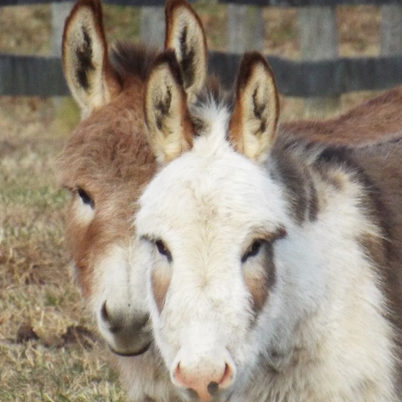Donkeys: The Forgotten Equine
How many times have you driven down the road and noticed donkeys out in a lush pasture, eating grass with horses, cows, goats, sheep or alpacas? You probably thought, “Oh, look how nice, such a cute donkey.” But what you probably didn’t realize is that the donkeys you saw eating in those nice grassy pastures are more than likely dangerously obese. Many have not had their feet trimmed or their teeth worked on by an equine dentist, or vaccinations given by a vet. You see, donkeys really are the forgotten equine. They are the most neglected, overlooked and mistreated member of the equine family. People mistakenly believe that donkeys are simple to care for and can just live out in a pasture with little to no care.
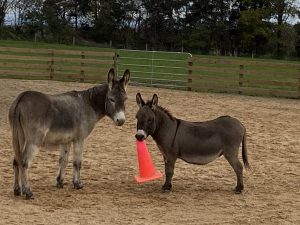
To properly care for a donkey, one must have a true understanding of equine care, and then an even better understanding of how to care for the equine with metabolic challenges, similar to most ponies or miniature horses. If you do not have extensive experience caring for horses or ponies, you will have a lot to learn before you should ever take on donkey ownership.
The first thing to understand is that donkeys are very efficient with what nutrition they take in. In that sense, they are the very definition of an “easy keeper.” But, that’s the only part that’s “easy.” They can, and do, get fat very easily without appearing to eat very much. But here’s the issue: nice green pasture is VERY high in sugar and very fattening for a donkey! Think of donkeys as you would a diabetic person. Grass is to a donkey like cookies are to a human diabetic. And while it seems “natural” that they should be able to graze out in the pasture like all the other types of livestock, the truth is they cannot, at least not in parts of the country where grass is rich and green and plentiful.
Donkeys are desert animals and they are genetically designed to make good use of every calorie they take in. Donkeys are browsers. That means that they are meant to eat all kinds of dry grasses, brush, tree branches and scrubby plants. In the wild, they travel great distances every day looking for all their food. If you look at donkeys in the wild, they are a very healthy weight, and their feet look great. They naturally wear their feet off on the sand and rocks that they spend all day traveling on to find their food. 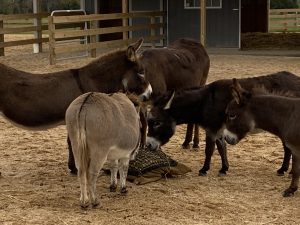
So, how should donkeys be cared for to keep them as healthy as possible? Well, the first thing — and one of the most important things — every donkey owner should have in place for their donkeys is a “dry” paddock. What we mean by this is a paddock with no grass. Ideally, this paddock would have nice footing in it like stone dust or sand to keep it from becoming a muddy mess when it rains. This paddock should be big enough for them to run around in, and it should be attached to their shelter. This dry paddock will be their home base. They will spend a great deal of time here, so it needs to be big enough to encourage plenty of exercise. This one element for donkey-keeping is where so many people fail their donkeys. People simply refuse to spend the money or effort necessary to create an environment that keeps the donkey healthy. Limiting their time on the grass will save their lives!
Donkeys can have some time on the grass, and we understand how important it is for the donkeys to have some enrichment, which includes grazing and playing in larger fields. It’s a fine balance. It’s important for them to exercise, and grazing does encourage that, but it’s also extremely important to carefully limit how much time they spend on the grass. This management is the responsibility of the donkey’s owner.
In some parts of the country this might be very easy because there might not be any grass to worry about. Or a person’s property might be perfectly set up to provide an area without grass for their donkey.
People often ask us, “How much time can my donkey spend eating grass?” There are so many variables that it is hard to give a simple answer, but here are some of the things to consider: what is the current health of the donkey? Is it obese already, or a perfect weight? How old is the donkey? How rich is the pasture, what kind of grass, etc.? Has the donkey foundered or had any issues with laminitis?
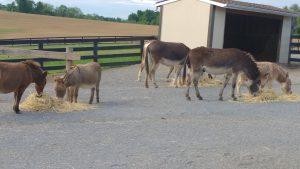
We use all of this information to help decide how much time the donkey can safely be out eating grass. Some donkeys might be able to spend half the day or all night out, while others might only be able to have a couple hours. And if they have foundered before or are prone to laminitic flare-ups, they might only be able to have an hour or less, or perhaps they’ll have to wear a muzzle while they are on the grass to limit their intake even more.
Basically, we tell people that they need to pay attention to their donkeys, and if they are gaining weight, then they are spending too much time on the grass. And, obviously, if they become sore in their feet, they definitely need to come off of the grass entirely.
So, while donkeys can’t spend very much time on the grass, and need to spend most of their time in paddocks without grass, what should you feed them? The general rule of thumb to remember for donkeys is that they need a very high fiber, LOW sugar diet. That means long stem hay, and generally first cutting hay is best. No alfalfa, clover, second or third cutting hay — these are all too rich, higher in sugar and protein, which is also harder for donkeys to metabolize properly. 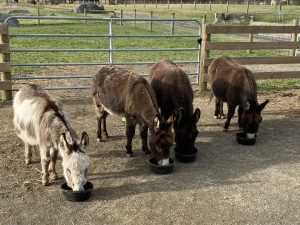 Virtually no grain is necessary for donkeys. A very small handful of a ration balancer or “lite” feed is fine: it helps establish a routine with the donkey, and helps the owner check in and make sure the donkey is feeling ok. But for nutritional reasons, healthy donkeys do not need and should not be fed any significant amount of grain.
Virtually no grain is necessary for donkeys. A very small handful of a ration balancer or “lite” feed is fine: it helps establish a routine with the donkey, and helps the owner check in and make sure the donkey is feeling ok. But for nutritional reasons, healthy donkeys do not need and should not be fed any significant amount of grain.
